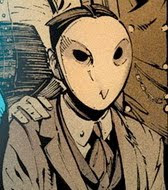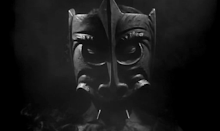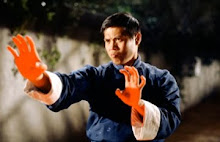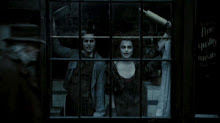The strange thing about my set of answers is that they contradict each other. Only a true cynic is supposed to choose Keaton over Chaplin and only a sloppy sentimentalist could prefer Truffaut to Godard. So I contradict myself. It won’t be the first time or the last.

In both cases it comes down to a pure gut level reactions. I enjoy and respect Chaplin’s films. I’m in awe of Keaton’s. It’s not as if I don’t like Chaplin. It’s that I can comprehend him. He’s a genius pure and simple. But his are the films of an extraordinary man visiting the ordinary. While Keaton’s are the films of ordinary man making himself extraordinary. Chaplin’s films coast along buoyed by the zephyrs of genius, Keaton’s on the other hand always seem earth bound. The result not of divine inspiration but of craftsmanship so fine and single minded that it borders on obsession.
Virtually every scene in Sherlock Jr. has a precision to it that frankly makes my head hurt. At a scant forty five minutes Sherlock Jr. packs in enough great scenes for an entire career. It serves as a perfect distillation of what makes Keaton great… And hell with it, why don’t you just go ahead and watch this one along with me.
The film starts off with a slow burn. The kind of humor, like the gag of Keaton continually finding the dollars in the rubbish before being forced to give them back are the types of routines that he would have no doubt perfected in his days on the vaudeville circuit. They could easily be performed on the stage. It’s not always wise to read to much into a director’s supposed motivations. Particularly one who played things as notoriously close to the chest as Keaton did. And yet, it is so easy to believe this intentional, a taste of the old to contrast the new. Of all of Keaton’s films Sherlock Jr. is the most cinematic. It positively bursts with the possibility of what a sharp mind and a camera can accomplish.

Normally it’s Chaplin whose considered the great master of the close up. But here too I think that Keaton is the superior. If only by virtue of his generosity. Take the above shot of the Shop Girl, after she has just turned down Keaton's attempt to buy the most expensive box of candy at a discount. The shot has little to no bearing on the plot. The character aside from a quick moment with Keaton’s rival is never seen again. But that moment adds so much, that look equal parts affection, solidarity, and amusement create a character were Chaplin would have only had an impediment.
Minute Fourteen launches the film into its first real virtuosic sequence. Keaton’s deadpan referred not only to his face but the way he presented his set pieces.

A sequence like that looks almost comically simple, until you stop and think about the precision and practice it must have taken. Yet it all looks so effortless. And it’s only about the sixth most complicated sequence in the film.

The theater sequence is of course the most complex scene in the film. And the most justly famous. If watching this sequence doesn’t give you something akin to the screaming mimi’s I can only conclude you know very little about film production. Creating a sequence like this now would cause someone to break out in cold sweats. Creating it then places Keaton somewhere far beyond the level of virtuoso. Word’s can’t do it justice. Just watch.
The film ends with one of the most breathlessly executed stunt scenes ever recorded. A ten minute compendium of the impossible that just keeps escalating.
But it’s not just awe that draws me back to Keaton. And it’s not just the fact that his films are fall down hilarious (Did I mention that?) His films were just as ahead of their time thematically as they were in technique. Look at the end scene, with Keaton literally taking his cues about what to do in real life from the film he’s watching. That sequence is so far ahead of its time that it laps its contemporaries. While his contemporaries were content to treat it like a toy, Keaton, like Munrau knew exactly what the cinema was. And he would never quite get the credit he deserved for it.

A lot of the credit for the introduction of self consciousness to cinema ended up going to the French New Wave boys and the two kings at the movement’s center. While in the case of Keaton Versus Chaplin I retain a large amount of affection and respect for the opposite number, in the case of Truffaut and Godard my feelings are completely binary.
Simply put I don’t respond to Godard films. At all. There’s something on what feels like a chemical level that keeps me from responding to his work. Truffaut’s early death and Godard’s Highlander like life span have long been proof to me that the good die young and the bastards live forever.
My love for Truffaut was equally immediate and complete as my disdain for Godard. The delicacy of his films, that mixture between their passion and innate shyness, the complex emotional state of his characters and Truffaut’s engrained humanism and compassion for them. And above all the love of cinema expressed not through mere regurgitation but in exhilaration at the act of creation itself.
I know that it is 400 Blows and Jules And Jim that are the canonical classics. But so help me I prefer Shoot The Piano Player to the both of them. Shoot The Piano Player, is based off of David Goodis’s pulp novel. A story of a mild mannered cabaret piano player who is dragged by fate and familial ties back into the life of criminality he’s worked so hard to sever himself from. Dire consequences result.
While both The 400 Blows and Jules And Jim are the more openly emotional films, Shoot The Piano Player is paradoxically, his deepest felt. Like its hero the film is steely and taciturn on the outside, a raw nerve within.
And yet for all the pain in the film, Shoot The Piano Player never feels dreary. On the contrary it is among the most light on its feet films of The French New Wave. A cinematic movement renowned for its nimbleness. The film seems positively giddy at what it can do. When a cabaret singer performs a song (in its entirety) the lyrics bounce jauntily across the bottom of the screen as if inviting the audience to sing along. When one of the criminals makes an oath to his young kidnap victim on the health of his mother, we’re treated to an insert shot of the old lady keeling over in a silent film style gag. Or take the film’s central knife fight which swings from violence to pathos, to humor, to violence again in a scene that shifts tone approximately a dozen times in a single scene. In each instance one can almost feel Truffaut’s nervous style. “Can I do that?” one hears him ask, “Well I guess I can.” Is more often then not the answer.
But when the film intends to bruise and it does, the film has no trouble shedding its stylistic innovation. The reason is simple. While Godard would use such tricks to tell you that you are above the narrative, Truffaut uses them to tell you that you are never above the narrative. It is the narrative that brought you here in the first place.
Shoot The Piano Player is the film that best articulates the differences between Godard and Truffaut. Goddard dissected the B Movies of his past so he could have an intellectual response that was above them. He manufactured cinematic valentines to his own cleverness and chic politics. Truffaut dissected them to discover what it was that made him so deeply feel them in the first place. As a result Godard’s cinema is ultimately one of detachment while Truffaut’s is one of furious attachment.
Like Keaton at the end of Sherlock searching for clues Truffaut is all to aware that the movies matter. They may be illusions. But nothing is an illusion inside our heads.





































































































No comments:
Post a Comment